How to start a contact center: A guide by a contact center team lead

Customer Support Manager - Tier 1
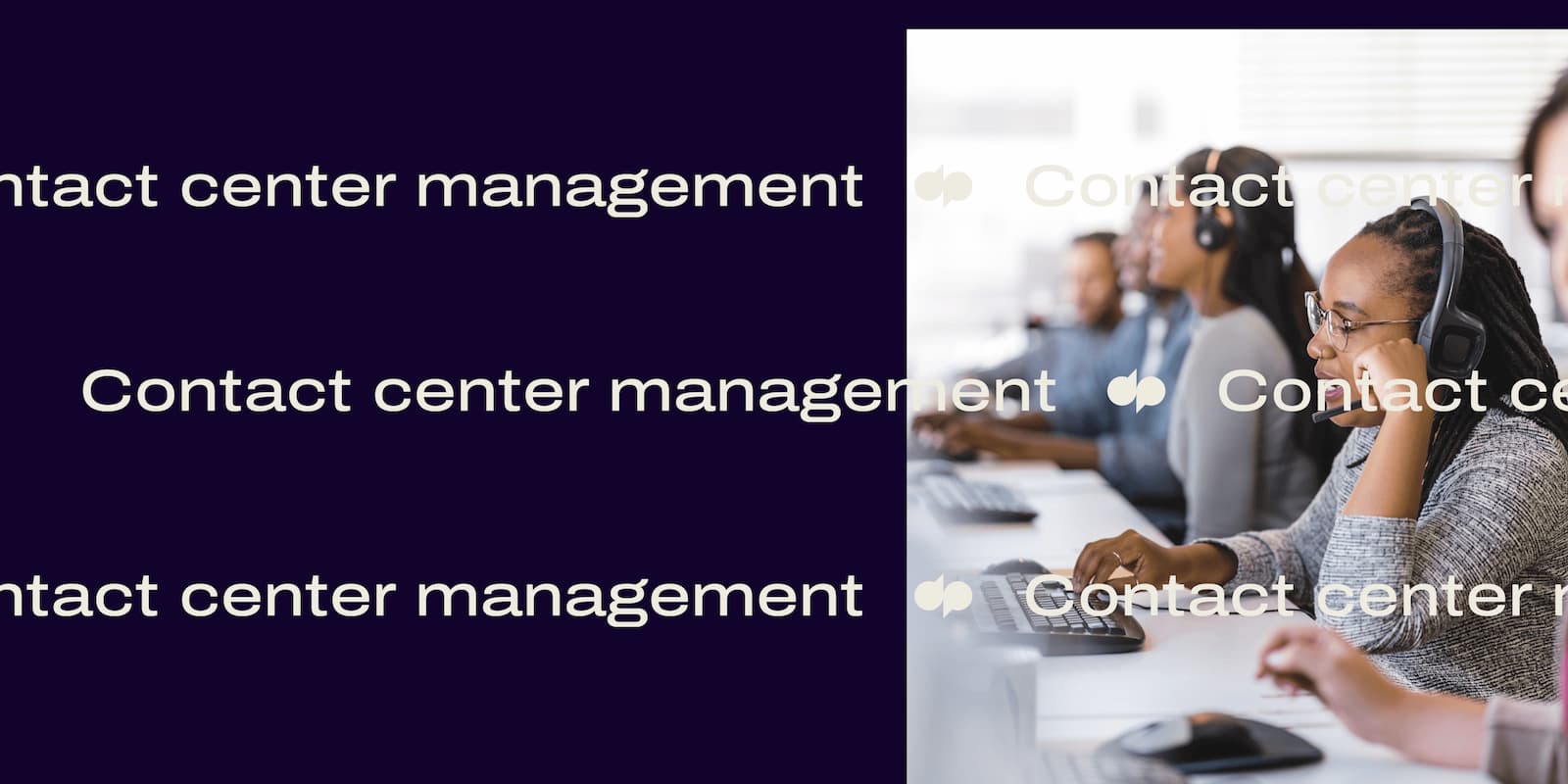
Tags
Share
Setting up a contact center is a significant step for any team lead or business owner. It’s also a business idea that requires robust planning and the right tools to succeed.
Having worked as both a technical support rep and now a team lead at Dialpad, I’ve learned a few things about setting up a hosted contact center—and I’ll be sharing those tips in this guide.
I’ll outline everything you need to know, from planning, all the way through to execution and monitoring.
Do you need a new call center… Or a contact center?
Before we go any further, let’s clear up this common misconception.
A call center is not a contact center—and there are definitely some nuances between a contact center versus a call center business.
While some people use these terms interchangeably and while they do have a lot in common, contact center and call center services are two different beasts.
A call center usually deals only with inbound and/or outbound phone calls.
A contact center, on the other hand, goes beyond phone calls and covers multiple communication channels. And that’s essential in this day and age, because customers expect convenience, flexibility, and the ability to choose their preferred mode of communication.
The most common modes of communication that a contact center might cover:
Text messages (SMS & MMS)
Live chat
Email
Social media
Video meetings
👉 Fun fact:
At Los Angeles Pacific University, student success coaches have seen much improved response rates by reaching out to students via text or SMS. Are you on the channels that your audience is on?
Looking to start a call center? 2 quick questions to figure out if you should opt for a contact center instead
Most businesses today will benefit from switching their communications infrastructure to a contact center model. Here’s how to tell if your organization should think about a contact center instead of just a call center.
Does your audience expect you to be there?
This is the easiest way to tell. If your customers (or your potential clients, or whoever you’re trying to communicate with) are using, or want to use, not only phone calls but also communications channels like live chat and video calls to reach you, then a contact center is for you!
Do you need a better way to track KPIs and agent performance?
Contact center solutions today are pretty robust, and come with built-in tools to help businesses continually improve on their agent performance.
Having different channels available also helps a contact center answer customer queries much more efficiently. For example, one agent can handle only one phone call at a time, but may be able to do two or three chats at once. (Alternatively, you could rotate your agents so that they can focus on live chat or just the phones today.)
Dialpad integrates with many customer engagement tools, like Zendesk, Front, and Intercom to help you cover all your channels easily. More importantly, it has its own omnichannel experience, which lets you handle conversations across live chat, WhatsApp, Facebook Messenger, and much more:
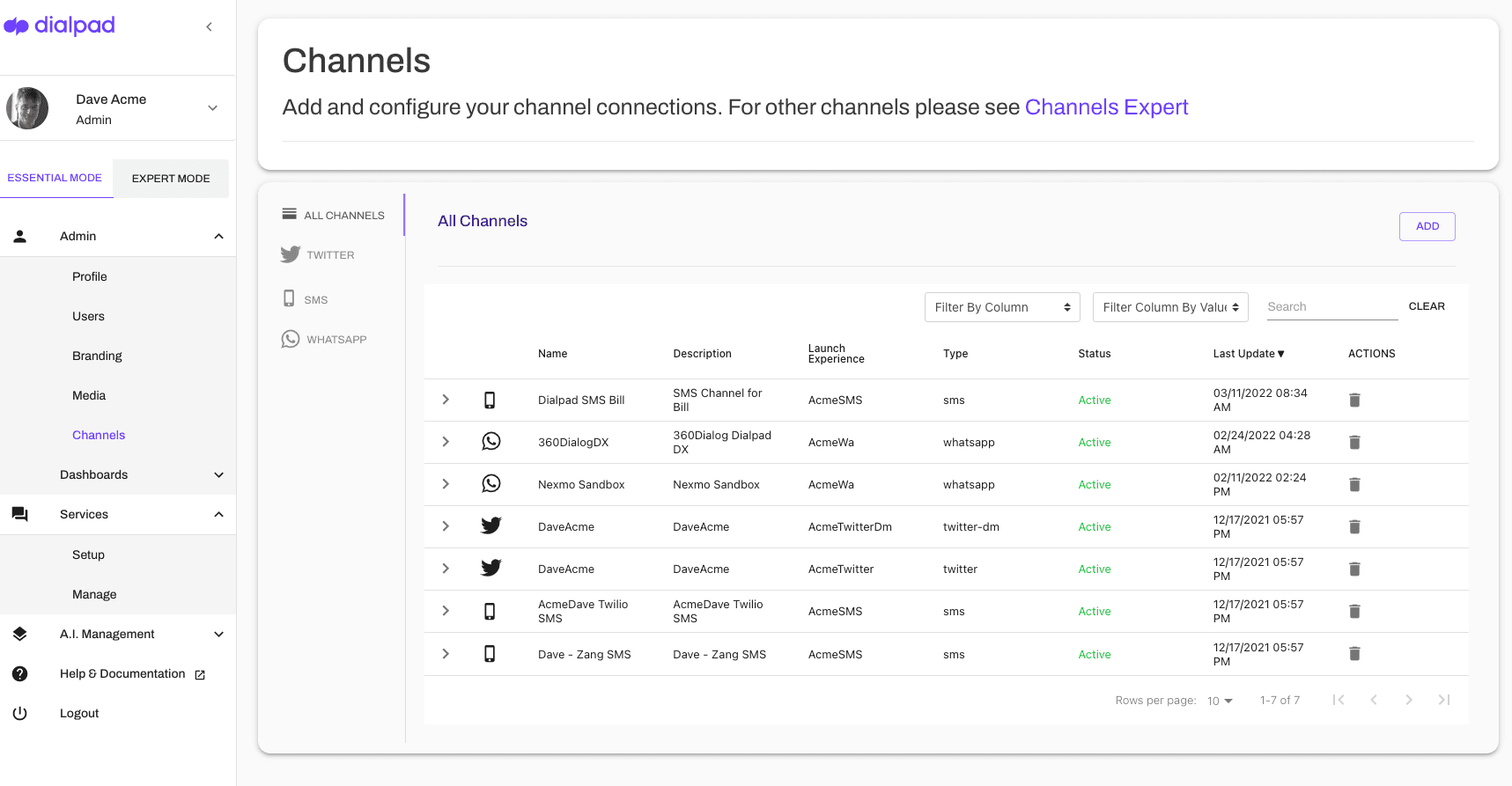
How to start a contact center in 3 steps
Ready to turn your own call center into a contact center?
Whether you’re running a customer support team or a financial services contact center, this step-by-step guide will help you get up and running in three simple steps.
1. Create a business plan
Map out your journey from call center (or your “starting from scratch” state) to contact center. Your new business plan should outline why you are implementing a contact center, and your projected outcomes.
Additionally, when creating your business plan, you need to understand business structures like sole proprietorships, S corporations, and LLCs. You can form an LLC to separate your personal assets from business liabilities, as well as providing tax flexibility.
A good contact center business plan should include things like:
Number of employees to hire
This is one of the first decisions you should make when planning your contact center. You’ll need to know how many employees you’ll need to hire, and by extension, how much equipment (like headsets), technology, and office space you’ll need to equip them.
Consider these factors to help you plan the scope of your contact center:
Expected call volumes
Number of communication channels you’ll cover
👉 Fun fact:
Fenway Health keeps a whopping 600+ employees connected across its many contact centers. See how they manage their vast network of distributed employees!
Kind of operations to handle
Will you deploy an in-house (internal) contact center operation, or outsource to a third-party?
If opening a contact center is going to involve relocation, provisions for this move should also be outlined in your business plan (for example, if you’re opening a contact center out of town, overseas, or if you’re planning on outsourcing your contact center).
Processes to implement
Outline all the processes that you will implement in your contact center. This will include things like customer support, sales calls, incoming/outgoing communications, social media activity, email communications, account and billing tools, order management, reporting, etc.
Costs to incur (budget plan)
Finally, close your business plan by setting a realistic budget that takes into account all the costs you are likely to incur by setting up and running (or outsourcing) a contact center. Consider both one-off costs, and recurring expenses.
One-off costs include things like:
Contact center equipment
Website development
Marketing/ ad spend
Recurring expenses include things like:
Salaries
Business registration fees
Rent and utilities
High-speed internet
Software subscriptions
Using a SaaS model service (more on CCaaS) is a great way to control spending, since cloud contact center solutions like Dialpad are cost-effective and make it easy to set up and deploy a cloud-based contact center for a recurring monthly subscription fee that you can scale up or down as and when needed.
That means you’ll always know exactly how much money is coming out of your account each month so you can plan and budget more accurately.
(Plus, because Dialpad deals with the entire backend, you’ll never have to worry about unexpected hardware or maintenance costs.)
2. Determine the setup and focus of your contact center
Your business plan is just the first step in your contact center preparations. You still have plenty more decisions to make.
You’ll need to decide whether yours is to be an on-site, remote, or hybrid contact center, and whether you’ll engage primarily in outbound or inbound calls, and the industry within which you’ll be working.
Locate yourself—onsite or remote?
Decide whether you will run your contact center on-site or remotely (or a combination of the two). The location of an on-site contact center should take into account employee proximity and accessibility. If you’re going remote, the key consideration will then be equipping your teams with all the technology and equipment they need to work from home.
On-site contact center
An on-site contact center will need to operate from a central office where all your employees will report for work each day. This is the best option for fixed-location business, those with large teams, or for centers dealing with high-compliance cases.
However, there are downsides to choosing on-site deployment. It lacks the flexibility of remote working (something which more and more employees want), and it can often end up being more expensive (think rent, setup, maintenance).
If you are setting up an on-site contact center, take into account the location’s proximity to company HQ and accessibility for your employees. (Are there good transport links?
Remote contact center
A remote contact center (or virtual call center) will operate from disparate locations, with most employees choosing to work from home. That means all of your company interactions will take place over an Internet connection. Today, that’s pretty easy to do, since most software uses VoIP technology to make it possible to have phone calls over the Internet.
Virtual contact centers reduce costs (less upfront capital and recurring bills), and increase flexible working options for employees.
See how Ace, a company that services residential customers with electric, plumbing, and HVAC services throughout Central Florida, went from a simplistic cloud-based call center system to a more robust contact center platform with features like live call monitoring:
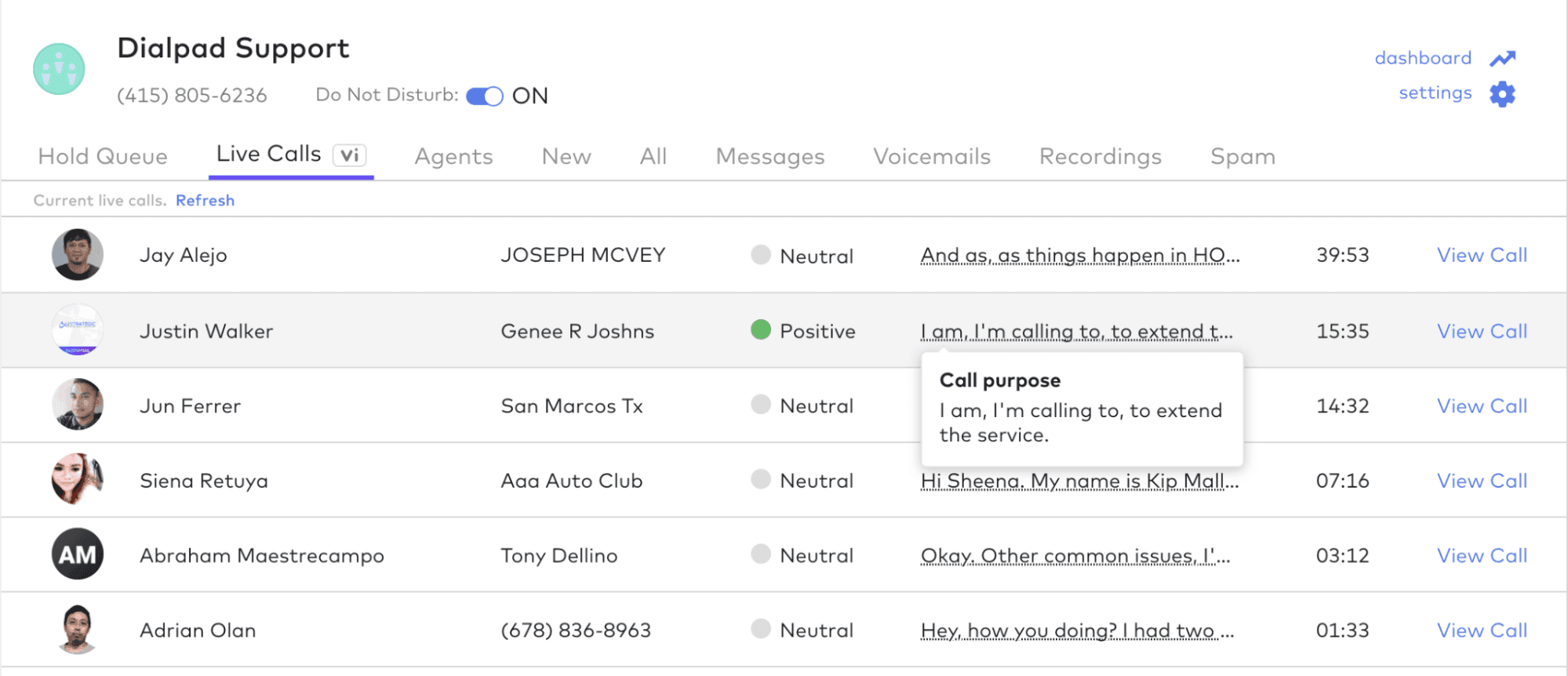
Decide the focus of your services
Identify the key services that your business needs. Is your contact center for outreach, inbound calls and messages, or a combination of the two?
Outbound call centers or contact centers are concerned with making calls to potential customers (often via sales dialers). They are typically associated with sales calls (or cold calling) made to new customers, telemarketing, surveying, and appointment scheduling activities.
Dialpad Support has features designed for this, like voicemail drop, which lets reps "drop in" a pre-recorded voicemail message instead of reciting a message every time they get sent to voicemail:
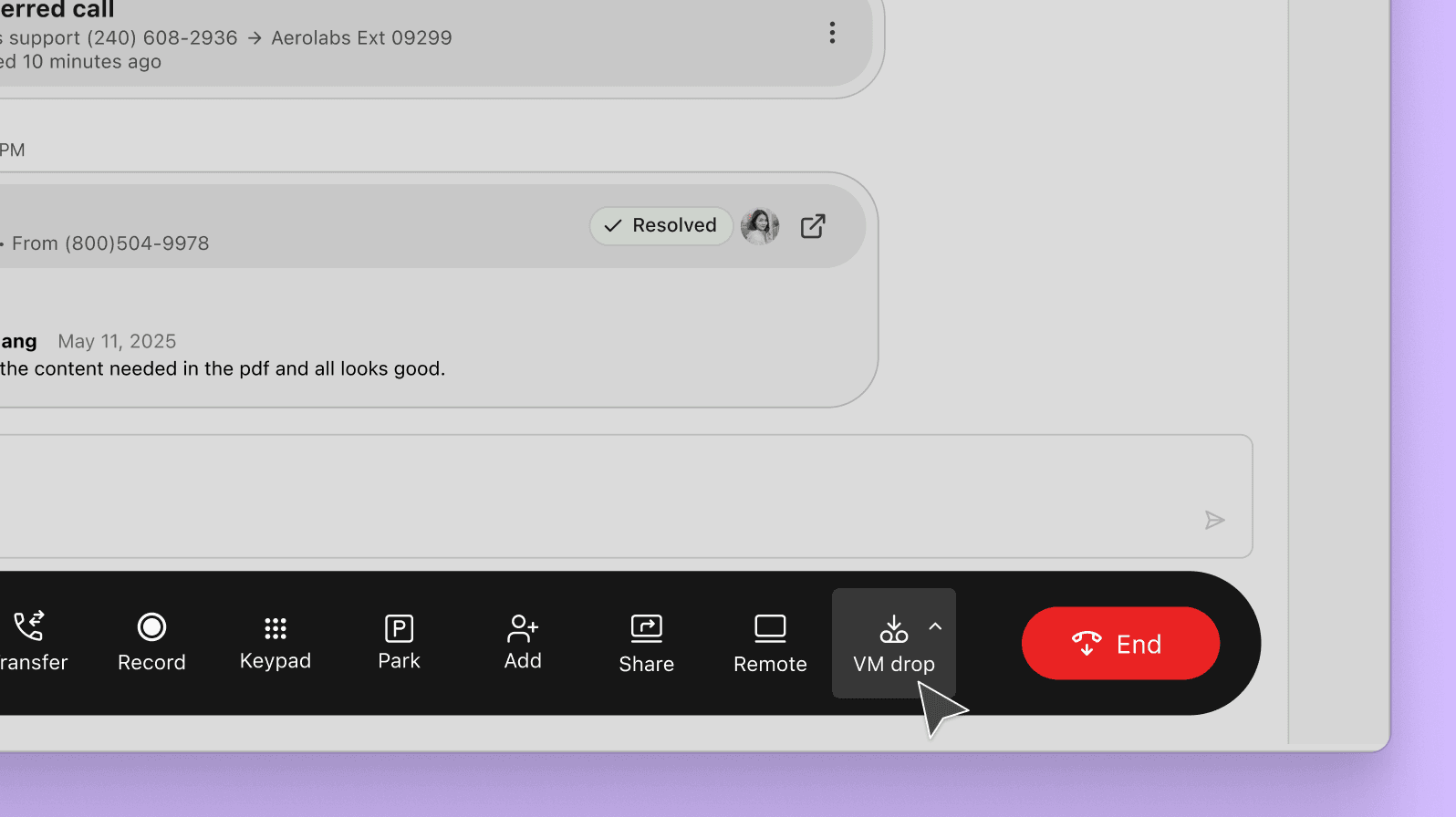
Inbound call centers and contact centers, on the other hand, receive calls and messages from customers (or prospects, or employees, and so on). They are typically concerned with offering support services in response to their inquiries. For example, an inbound contact center might offer payment and order processing, help desk support, or over-the-phone processing upgrades and renewal requests.
Consider the industry that your contact center is in
The last factor to consider when determining the setup and focus of your contact center is industry. If you’re starting up your business for the first time, make sure to explicitly identify your particular industry of focus and align your contact center operations accordingly.
Certain industries will require certain features and staff considerations. For example, a software company will need to employ technically savvy agents. Likewise, a medical company would need employees and resources with a certain level of medical expertise.
Choose the tools that fit your contact center needs
And of course, you need the right tools for the job!
Three of the most important contact center tools are your contact center platform or software, a CRM, and ideally, some type of performance monitoring or QA tool.
Let’s take a look at each of these in more detail.
1. A contact center platform
This is a must-have. Your audience needs some way to reach you, and if they’re using phone calls or text messaging, you’ll need a contact center platform.
This platform should have a built-in phone system (meaning it can take phone calls and SMS messages), and it should also have other channels if you use them.
For example, Dialpad’s platform lets you talk, message, and meet—all in one app—and it works on mobile too, which means agents could work from their phones as well as their computers.
The best thing is that it’s designed for both external and internal communication. That means agents can communicate with customers and also their teammates and supervisors from the same app.
Not only that, supervisors can see at a glance whether their service levels are up to standard:
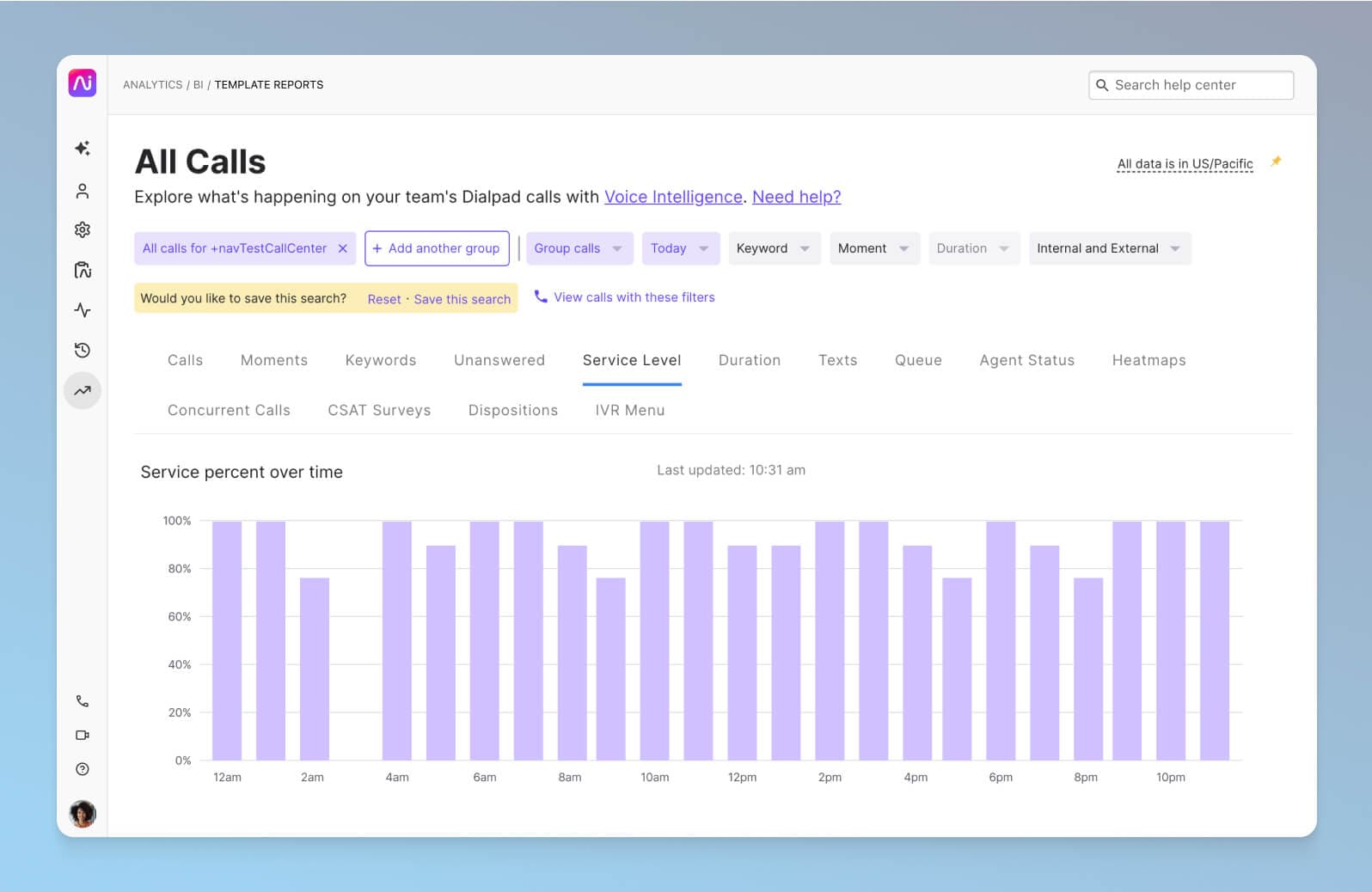
If you’re running a remote or hybrid contact center, then you’ll definitely want to look at a unified communications platform like this, that uses VoIP technology.
2. CRM (customer relationship management) system
A customer relationship management system is a software tool that organizes and stores customer records and data. Using a CRM helps organizations make more customer-centric decisions that improve customer interactions and reduce repetitive work and questions.
For example, a core function of any CRM—when properly integrated with a contact center platform—is to display customer details on calls. When agents have those details right there in front of them, it makes it so much easier to address each caller’s individual and specific concerns in a more personalized way.
Make sure that whatever telephony solution you’re using, it integrates with a CRM. Dialpad, for example, offers integrations with a wide range of popular CRMs including Salesforce, Kustomer, HubSpot, Kizen, and more (all of which are available on the App Marketplace).
These integrations embed a computer telephony integration or CTI dialer inside those tools, which allows agents to have phone calls without leaving the window or toggling back and forth between tabs:
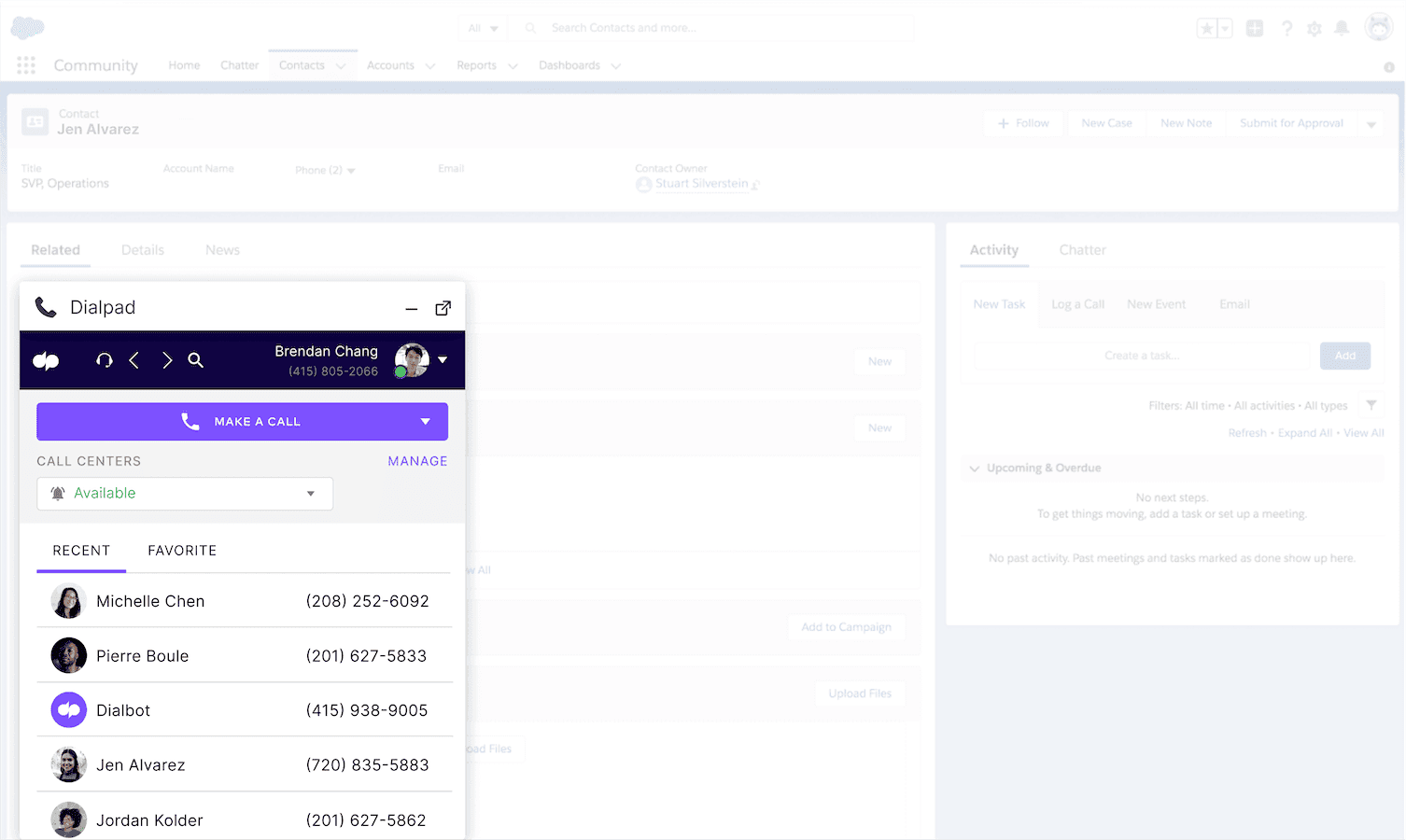
3. Performance monitoring tools
Lastly, make sure that your contact center is equipped with performance monitoring tools to observe, track, and log operations, performance, and any irregularities or shrinkage issues as they arise. After all, how else would you be able to tell if you’re tracking well against your customer satisfaction goals?
With the help of performance monitoring tools, contact centers can embark on a process of constant improvement, making any necessary changes as-and-when a situation calls for it.
Dialpad Support, for instance, comes with built-in analytics and dashboards that show you things like how many missed and abandoned calls are occurring:
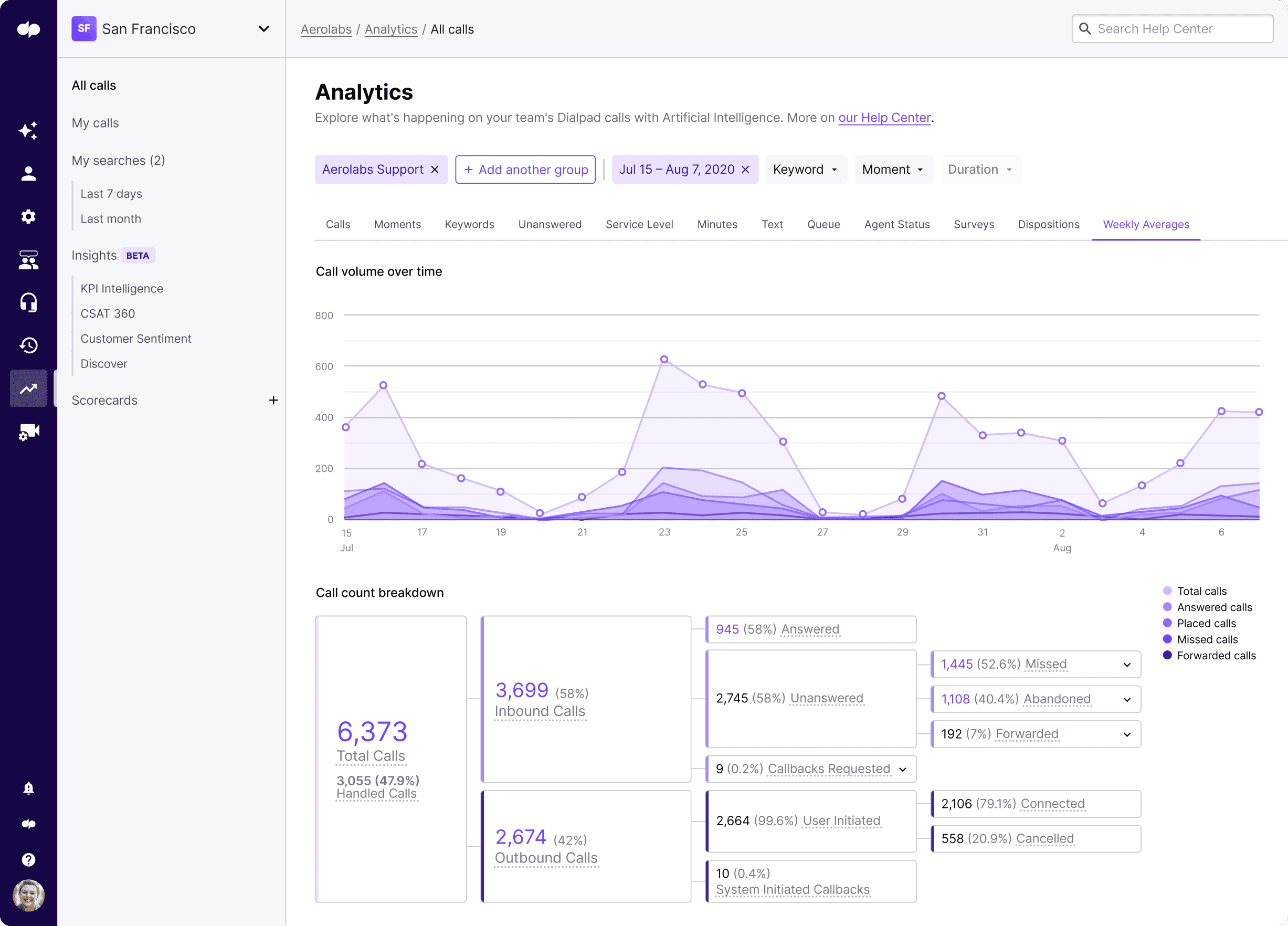
Fun fact: Dialpad also integrates with Playvox to give you robust WEM/WFM tools that help with contact center forecasting, scheduling, and more:
Staffing: How to put together your contact center team
Now that the backend is sorted, it’s time to populate your contact center with the best talent out there. You’ll need to define the roles that need filling, develop a recruitment marketing campaign, ensure that you’re able to measure progress, create a training program, and define your company culture.
1. Determine the roles/positions your contact center needs
Start by finding suitable candidates to work for your contact center. What are the characteristics of your ideal contact center representative? For example, would you need them to work flexible hours? Do they need comprehensive experience? Should they have technical knowledge?
Now’s a great time to create some exemplar resumes for your ideal candidates. Create one for each role that needs filling.
Typically, a contact center will be made up of employees carrying out the following roles:
Contact center agent or rep
Contact center manager
Team lead
Director of customer services
Operations manager
Trainer/ educator
Quality analyst
2. Develop a recruitment process for everyone, from managers to agents
Your recruitment process should be shaped by the type of candidates you’re aiming to target. For example, if you’re a local business setting up an on-premises contact center, you might want to target local employees in your city or region.
If you’re operating a remote contact center then this might be less of a criteria, and your recruitment process might cross borders (in which case, make sure you’re making all of the necessary language and time-zone provisions for your candidates accordingly).
A great way to identify the best employees from your pool of applicants is to give each applicant an assessment or trial period. This will help both you and them to figure out whether they’re a good match with your organization.
Finally, remember that most contact centers spend a lot of time dealing with customers. It’s important that contact center employees have the core traits of empathy, resilience (customers aren’t always nice), a detail-oriented mindset, confidence, and that all-important spark!
3. Know how you will measure performance
Contact center metrics are going to be a central part of this process. They will help you measure the success of your contact center operations in general, as well as individual agents and representatives on the job.
These are essential contact center KPIs that you’ll want to consider tracking in your center:
Average talk time: This is the average amount of time (in minutes and seconds) that passes between the agent picking up a call and the caller then hanging up.
Average handle time: This is the average length of time that a customer spends on a call (including all points of contact).
Average speed to answer (ASA): This is the amount of time it takes for a customer to reach an agent, including the call routing and queuing process. Dialpad has a heat map that shows you this so you don't need to calculate anything:
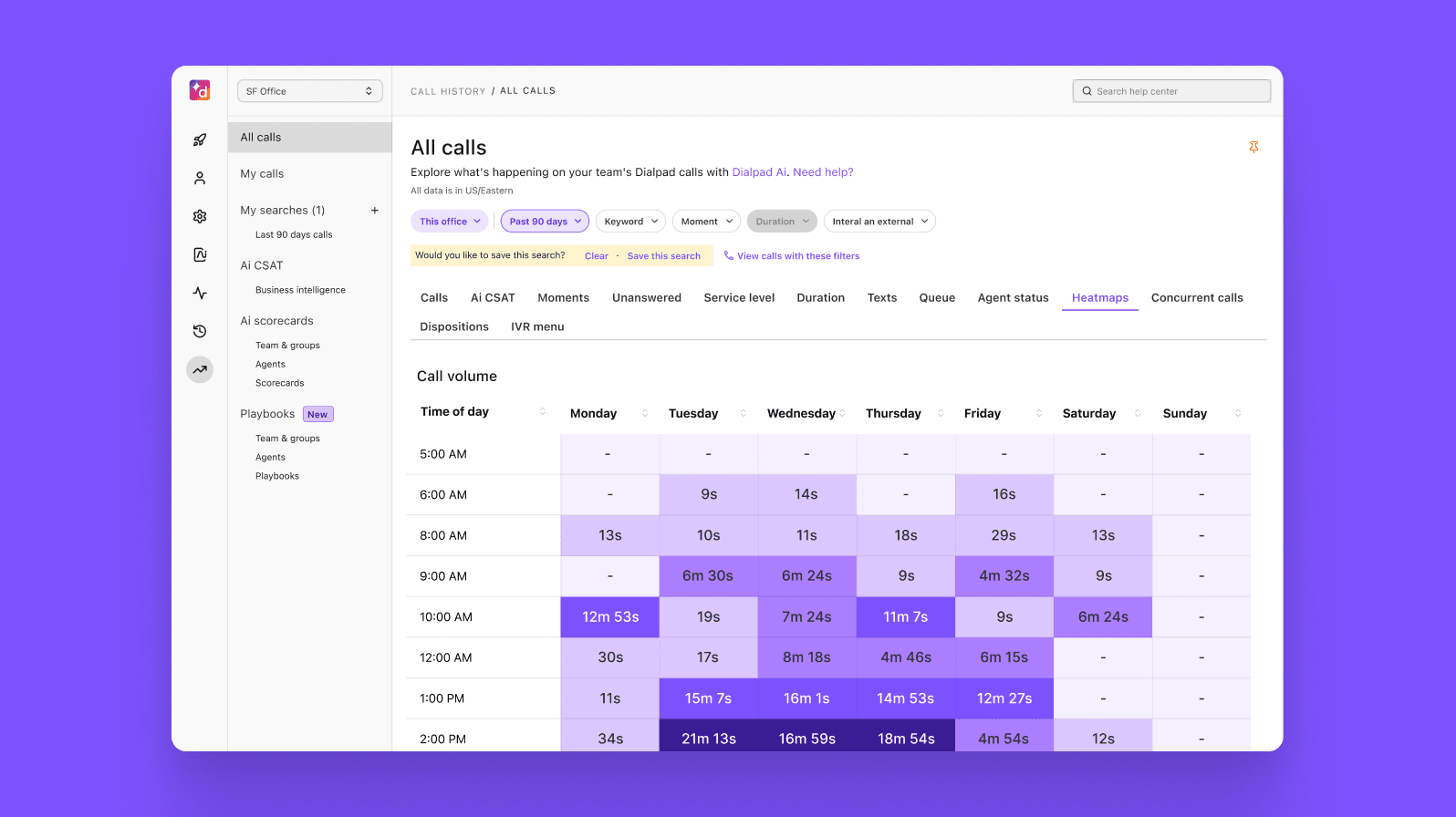
Declined call rate: The number of calls actively refused by an agent (in an inbound contact center this suggests that call volumes exceed contact center capacity).
Missed call rate: The number of unanswered calls that were not picked up by an agent in time. Missed calls are a common problem in overstretched contact centers.
👉 Further reading:
Rently is a prime example of this. After a period of exponential growth, the company realized they needed better analytics to empower their support teams. Dialpad gave the team real-time AI-powered analytics and now, they're maintaining an incredible 4.5+ CSAT score.
Transfer rate: This is the percentage of inbound calls that agents transfer to other team members or departments.
4. Create an ongoing training program
Being a successful call center agent comes with a lot of challenges, and agents must be trained to deal with the ups and downs of customer support. Try to offer training events that cover core contact center issues like effective communication, empathy, and your organization’s particular service level standards and expectations.
And don’t stop there.
Modern contact and call center software has revolutionized the way contact center managers can train their staff. One thing that's unique about Dialpad's contact center solution is that it uses Dialpad Ai to let you do training in real time—at scale—while agents are on calls.
Not only can Dialpad Ai track how often certain keywords are coming up on calls (like "refunds" or "money back," for instance), it also lets you create Real-time Assist (RTA) cards with tailored notes. These RTA cards can be set to trigger when those keywords are spoken!
For example, if I find that our customers ask lots of questions about how to port numbers and we just hired lots of new agents, I could create an RTA card to help them speak to this topic:

This is a great way to do ongoing training and development for your contact center—without having your supervisors personally sit in on every single call.
With all these extra resources in Dialpad, managers can easily oversee multiple agents on simultaneous active calls, while referring to built-in analytics to keep track of all those important metrics I just mentioned.
👉 Dialpad tip:
To create a coaching card go to Admin Settings > Call Centers > Create a Card. You’ll be able to choose whether you’d like to create a card from scratch or use a predefined template.
5. Define the team culture
You’ve got your business plan and started hiring an all-star team. Now it’s time to cultivate a positive and empowering team culture.
This is so important for performance and employee retention. It can be hard working for a contact or call center company. For teams to perform optimally, you’ll need a strong management team that’s ready and willing to support and motivate everybody.
Here’s how to find and define your own team culture:
Set out your core values and company mission
Recognize how you set the tone, and then be an example
Keep expectations clear for everyone
Explore how others do it
Keep the culture growing and evolving
Ready to provide a great customer experience with a contact center?
You’re ready to go. Time to start planning, executing, and deploying your very own contact center.
Setting up a contact center can seem like a daunting prospect for everyone (startups, small businesses owners, and enterprise businesses alike) but thanks to flexible, cloud-based SaaS service providers, it’s now easier than ever to get started.
Starting a contact center?
Or just looking to upgrade your call center? Book a demo of Dialpad to see how you can use it to set up remote agents around the world. Or, take a self-guided interactive tour of the app on your own first!
